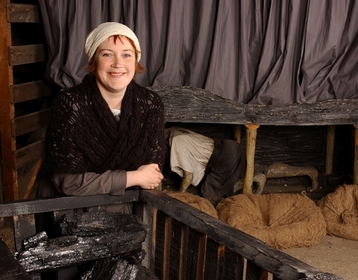Mining in the Victorian Age
A living history interpreter dressed as a girl working at the pit.
© National Coal Mining Museum for England (Photo: National Coal Mining Museum for England)
© National Coal Mining Museum for England (Photo: National Coal Mining Museum for England)
It was very common for parents to have as many as nine or ten children. In working class households the whole family was expected to work. Those children not sent out to work in factories and mills had to help support their family by doing chores around the house or making items to sell.
One of the biggest problems facing Victorian society was how to feed a population that was growing at an alarming rate. In pre-industrial Britain, the majority of people worked on the land and produced their own food. Most people now worked in factories and had to buy all their food with their wages, marking the beginnings of the modern consumer society.
In smaller towns, and in villages, street tradesmen still carried their wares door-to-door. Milk, fresh bread, fish, dairy products and vegetables were often sold this way, but in larger towns, especially towards the end of the 19th century, improved standards of hygiene meant that more and more people bought their food from shops.
One of the biggest problems facing Victorian society was how to feed a population that was growing at an alarming rate. In pre-industrial Britain, the majority of people worked on the land and produced their own food. Most people now worked in factories and had to buy all their food with their wages, marking the beginnings of the modern consumer society.
In smaller towns, and in villages, street tradesmen still carried their wares door-to-door. Milk, fresh bread, fish, dairy products and vegetables were often sold this way, but in larger towns, especially towards the end of the 19th century, improved standards of hygiene meant that more and more people bought their food from shops.


